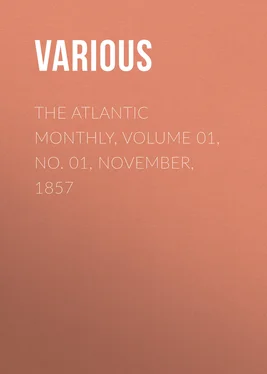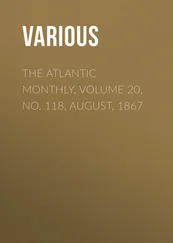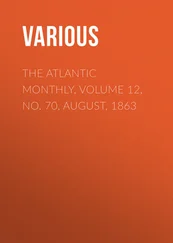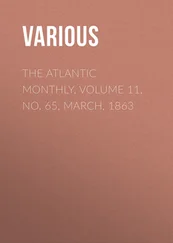Various - The Atlantic Monthly, Volume 01, No. 01, November, 1857
Здесь есть возможность читать онлайн «Various - The Atlantic Monthly, Volume 01, No. 01, November, 1857» — ознакомительный отрывок электронной книги совершенно бесплатно, а после прочтения отрывка купить полную версию. В некоторых случаях можно слушать аудио, скачать через торрент в формате fb2 и присутствует краткое содержание. Жанр: foreign_antique, periodic, foreign_edu, на английском языке. Описание произведения, (предисловие) а так же отзывы посетителей доступны на портале библиотеки ЛибКат.
- Название:The Atlantic Monthly, Volume 01, No. 01, November, 1857
- Автор:
- Жанр:
- Год:неизвестен
- ISBN:нет данных
- Рейтинг книги:3 / 5. Голосов: 1
-
Избранное:Добавить в избранное
- Отзывы:
-
Ваша оценка:
- 60
- 1
- 2
- 3
- 4
- 5
The Atlantic Monthly, Volume 01, No. 01, November, 1857: краткое содержание, описание и аннотация
Предлагаем к чтению аннотацию, описание, краткое содержание или предисловие (зависит от того, что написал сам автор книги «The Atlantic Monthly, Volume 01, No. 01, November, 1857»). Если вы не нашли необходимую информацию о книге — напишите в комментариях, мы постараемся отыскать её.
The Atlantic Monthly, Volume 01, No. 01, November, 1857 — читать онлайн ознакомительный отрывок
Ниже представлен текст книги, разбитый по страницам. Система сохранения места последней прочитанной страницы, позволяет с удобством читать онлайн бесплатно книгу «The Atlantic Monthly, Volume 01, No. 01, November, 1857», без необходимости каждый раз заново искать на чём Вы остановились. Поставьте закладку, и сможете в любой момент перейти на страницу, на которой закончили чтение.
Интервал:
Закладка:
The first public edifice of any importance erected in the city was a temple to Mars, with a colossal statue of that divinity in the midst of it. This is the present baptistery, formerly cathedral, of Saint John; for the temple never was destroyed, and never can be destroyed, until the day of judgment. This we know on the authority of more than one eminent historian. It is also proved by an inscription to that effect in the mosaic pavement, which any one may inspect who chooses to do so. 2 2 Villani, Cron. Lib. I. c. xlii.
The town was utterly destroyed A.D. 450, by Totila, Flagellum Dei , who, with great want of originality, immediately rebuilt Fiesole; thus repeating, but reversing, the achievement of the Romans five hundred years before. So Fiesole and Florence seem to have alternately filled and emptied themselves, like two buckets in a well, down to the time of Charlemagne. That emperor rebuilt Florence, but experienced some difficulty in doing so, by reason of the statue of Mars, which had been thrown into the Arno. The temple, converted to Christian purposes, had been the only building to escape the wrath of Totila; but owing to the pagan incantations practised when the town was originally consecrated to the god of war, the statue of that divinity would not consent to lie quietly and ignominiously in the bed of the Arno, while his temple and town were appropriated to other purposes. The river was dragged. The statue was found and set upon a column near the edge of the river, on a spot which is now the head of the Ponte Vecchio. True to its pugnacious character, it brought nothing but turbulence and bloodshed upon the town. The long and memorable feuds between the Guelphs and Ghibellines began by the slaying of Buondelmonte in his wedding dress, at the base of the statue. (A.D. 1215.)
There could be no better foundation for romance or drama than the famous Buondelmonte marriage, before which, sings Dante, Florence had never cause to shed a tear, and after which the white lily of her escutcheon was dyed red in her heart's blood. There were four noble families in Florence, of surpassing importance,—the Buondelmonti, the Uberti, the Donati, and the Amidei. A match-making widow of the Donati has a daughter of extraordinary beauty, whom she intends to bestow in marriage upon the young chief of the Buondelmonti. Before she has time to complete her arrangements, however, Buondelmonte betroths himself to a daughter of the house of Amidei. Signora Donati waylays him, as he passes the door, and suddenly displays to him the fatal beauty of her daughter. "She should have been your bride," said the widow, "had you not been so hasty." The gentleman, dazzled by the beauty of the girl, and satisfied by the prudent mother as to the dowry, marries Signorina Donati upon the spot. Next day, riding across the Ponte Vecchio upon a white horse, he is beset by a party of friends and relatives of the deserted damsel, and killed close by the statue of Mars. All the nobles of Florence take part in the question; upon one side the Nerli, the Frescobaldi, the –; but "courage, gentle reader," as Tristram Shandy observes, in his famous historical chapter upon Calais; "I scorn it; 'tis enough to have thee in my power; but to make use of the advantage which the fortune of the pen has now gained over thee would be too much."
Thirty years long, then, the town gates were all fastened, and the streets all chained, so as to make many little compact inclosures for slaughtering purposes; while the whites and blacks, Guelphs and Ghibellines, red caps and brown, all buffeted each other pell-mell. To the exhaustion thus produced of noble blood is often ascribed the establishment of a popular government at the close of the thirteenth century. The causes lay really much deeper, however,—in the great revolutions consequent upon the extinction of the Suabian dynasty, and in the wonderful progress in culture made by the Florentine democracy.
O Buondelmonte, quanto mal fuggisti
Le nozze sue per gli altrui conforti!
Molti sarebber lieti, che son tristi,
Se Dio t' avesse conceduto ad Ema
La prima volta ch' a città venisti.
Ma conveniasi a quella pietra scema
Che guarda il ponte, che Fiorenza fesse
Vittima nella sua pace postrema.
Con queste genti, e con altre con esse,
Vid' io Fiorenza in sì fatto riposo,
Che non avea cagione onde piangesse.
Con queste genti vid' io glorioso
E giusto il popol suo tanto, che 'l giglio
Non era ad asta mai posto a ritroso,
Nè per division fatto vermiglio.
II
SAN MINIATO
The walk to the church of San Miniato is a paved, steep path, through olive orchards fringed by a row of cypresses, to the little church of San Salvadore; thence, through a garden of roses and cabbages, fresh and fragrant in the December sun, to the convent of Miniato. From the terrace is one of the best views of the city; not so fine, however, as that from Bello Sguardo. The gentle, beautiful chain of hills which encircle Florence smile cheerfully in the sunshine, clapping their hands and skipping like lambs, if little hills ever did make such a demonstration. These environs of the town are like a frame of golden filigree, almost too fantastic a one for so shadowy and sombre a city. The green hill-sides and plains are sown thickly with palaces and villas glancing whitely through silvery forests of olives and myrtle; while the distant Apennines, like guardian giants, lift their icy shields in the distance.
The church is built upon the grave of the eminent saint, Miniato. This personage was, it seems, the son of the king of Armenia,—very much as all the heroes in the Arabian Nights are sons of the emperor of China. Having been converted to Christianity, he was offered by the emperor Decius great honors and rewards suitable to his royal rank, if he would renounce his faith. (A.D. 250.) He refused, and the emperor cut off his head. The execution took place in Florence, on the north side of the Arno. The holy man was not so easily disposed of, however; for he immediately clapped his head upon his shoulders again, and holding it on with both hands, waded across the river, and marched steadily up the hill on the other side. Arrived at the top, he gave up his head and the ghost. Hence the convent and church of San Miniato.
The church, to an architectural student, is interesting and important. A man needs a good eye and a good education to feel and thoroughly appreciate the grand symphonies which this wonderful architectural music of the Middle Ages has so long been silently playing. San Miniato belongs to the close of the Romanesque or Latin period. The early Christian school had expired in the midst of the general convulsions of the ninth and tenth centuries,—in the struggles of an effete and expiring antiquity with the brutal, blundering, but vigorous infancy of mediæval Europe. During the three centuries which succeeded, there was rather a warming into unnatural life of the mighty corpse, than the birth of a new organism, capable of healthy existence and unlimited reproduction. The Romanesque art seems to have dealt with the ancient forms, without moulding any thing essentially and vitally new. Where there seemed originality, it was, after all, only a theft from the Saracenic or Byzantine, and the plagiarism became incongruity when engrafted upon the Roman. Thus a Latin church was often but an early Christian basilica with a Moorish arcade.
The San Miniato has an arcade, of course not pointed, upon the façade and the interior. Its tessellated marble work, its ancient mosaics, with its Roman capitals and columns, all make it interesting. These last show that at the close of the epoch, even as at its beginning, the chain which binds the school to the ancient Roman is fastened anew.
Читать дальшеИнтервал:
Закладка:
Похожие книги на «The Atlantic Monthly, Volume 01, No. 01, November, 1857»
Представляем Вашему вниманию похожие книги на «The Atlantic Monthly, Volume 01, No. 01, November, 1857» списком для выбора. Мы отобрали схожую по названию и смыслу литературу в надежде предоставить читателям больше вариантов отыскать новые, интересные, ещё непрочитанные произведения.
Обсуждение, отзывы о книге «The Atlantic Monthly, Volume 01, No. 01, November, 1857» и просто собственные мнения читателей. Оставьте ваши комментарии, напишите, что Вы думаете о произведении, его смысле или главных героях. Укажите что конкретно понравилось, а что нет, и почему Вы так считаете.












